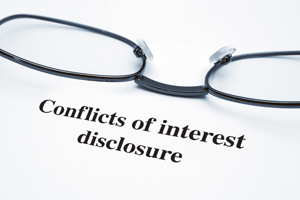CLINICAL practice guidelines are vulnerable to bias, with only 15% of NHMRC guidelines from Australia’s most prolific guideline developers including a declaration of conflicts of interest, new research has found.
Although a conflict of interest (COI) statement has long been required from authors of research papers, it is often lacking for developers of clinical practice guidelines, despite the influence of guidelines on clinical care.
The research, in the latest issue of the MJA, looked at more than 200 clinical guidelines that were listed on the NHMRC website. Its authors concluded that the NHMRC needed to “urgently promote a more ethically sound development process for guidelines”. (1)
“Guidelines are valuable and vulnerable”, the authors, led by Michael Williams, a researcher from the Michael Kirby Centre for Public Health and Human Rights at Monash University, wrote.
“Our review of the country’s most prolific guideline developers shows that only 15% of guidelines have COI statements”, they said.
“This raises questions about whether medical bodies are affected by unrecognised, and thus unaddressed, extraneous interests, and may erode the trust the community has in the profession to speak authoritatively about health problems.”
The authors said individuals, institutions and professional bodies could have COIs, with the most common being financial links to industry, such as being paid consultancy fees or honoraria, or holding company shares.
They proposed a six-step process for improving COI disclosure and suggested that the NHMRC should list whether existing guidelines contained a COI statement, and require a COI declaration for future guidelines.
The NHMRC should “prioritise the provision of updated advice on appropriate management and disclosure of COIs in guideline development”.
The problem of disclosure is international, with a North American study published in the BMJ showing that more than half of panel members producing guidelines on hyperlipidaemia or diabetes had conflicts of interest. (2)
This study also found that there was some underreporting of COIs. Among 73 panellists who formally declared no conflicts, 8 (11%) were found to have one or more.
“One suggested remedy is that guideline committees should be composed of only those who have no conflicts of interest”, an accompanying BMJ editorial said. (3)
“There is a charming sense of unreality about this suggestion — money from drug companies is the oxygen on which the academic medical world depends”.
What was needed was a change in the culture of medicine “in which serving two masters becomes as socially unacceptable as smoking a cigarette”, the BMJ editorial said.
Discussing the Australian findings, MJA editor Dr Annette Katelaris said the fact that only 15% of guidelines had COI declarations was surprising. (4)
She said the MJA would continue in its role as a repository of clinical guidelines.
“We already insist on a full conflict of interest statement for each contributor, and all guidelines published in the MJA are peer reviewed”, Dr Katelaris said.
– Linda McSweeny
1. MJA 2011; 195: 442-445
2. BMJ 2011; 343:d5621
Posted 17 October 2011

 more_vert
more_vert
Patients need to be aware that their doctor may not be acting in their best interests, or may be influenced to recommend something because they receive a royalty, incentive payment etc
I have never approved of the incentive payments received by GPs for pap testing. Most women are unaware of these payments and they’re not mentioned anywhere we’re likely to find or see. Most women take their doctor’s advice at face value and don’t consider what may lie behind the recommendations. I think these payments probably partly explain why women don’t hear about the risks of testing or the rareness of the cancer, only the risk they take if they don’t screen. Very one-sided and unfair to women.
I feel the screening authorities have corrupted the doctor-patient relationship – they are using our doctors to protect the program and its target, not us.
Our program is harmful and excessive and thankfully, more doctors are now warning women they don’t need 2 yearly pap tests and women under 25 should not be tested…that gives me hope. I hope GPs start to warn women about the risks with breast screening and not just recommend it because we have an expensive program with a target.
My brother-in-law has just had his hips replaced again after the joints starting leeching toxins into his system. He now knows his surgeon was receiving royalties to use the hip joints, including allegedly after he was aware there were problems with the joints. Has that shaken my BILs faith and trust in doctors? Of course…
No payments, royalties etc or at the very least, full and clear disclosure.
It apears that RACGP ‘standards’ for general practice are also subject to conflicts of interest as some of the members enforcing the standards are reported to have financial
interests in the products associated with the “standards”.
Most of the standards are not related to the practice of medicine but to the premises (surgery) as if the premises are subject to factory or commercial retail conditions – not consistent with the concept of professional practice.
These standards are merely de facto conditions for non-professional payments – added income for government subsidy.